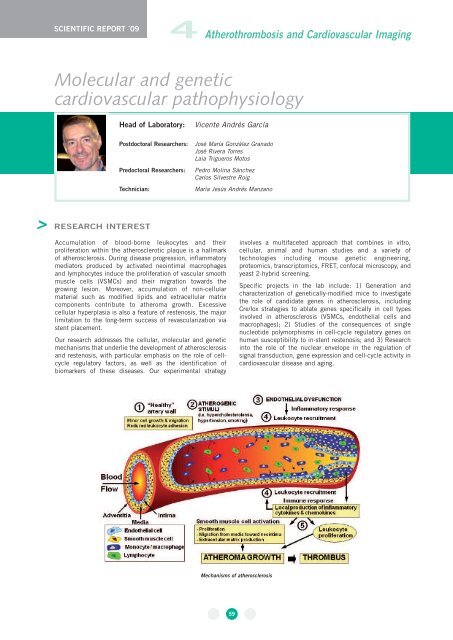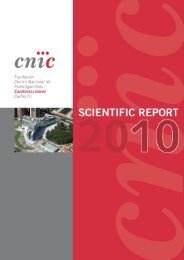Appendix - CNIC
Appendix - CNIC
Appendix - CNIC
Create successful ePaper yourself
Turn your PDF publications into a flip-book with our unique Google optimized e-Paper software.
SCIENTIFIC REPORT ´09<br />
> RESEARCH INTEREST<br />
Accumulation of blood-borne leukocytes and their<br />
proliferation within the atherosclerotic plaque is a hallmark<br />
of atherosclerosis. During disease progression, inflammatory<br />
mediators produced by activated neointimal macrophages<br />
and lymphocytes induce the proliferation of vascular smooth<br />
muscle cells (VSMCs) and their migration towards the<br />
growing lesion. Moreover, accumulation of non-cellular<br />
material such as modified lipids and extracellular matrix<br />
components contribute to atheroma growth. Excessive<br />
cellular hyperplasia is also a feature of restenosis, the major<br />
limitation to the long-term success of revascularization via<br />
stent placement.<br />
Our research addresses the cellular, molecular and genetic<br />
mechanisms that underlie the development of atherosclerosis<br />
and restenosis, with particular emphasis on the role of cellcycle<br />
regulatory factors, as well as the identification of<br />
biomarkers of these diseases. Our experimental strategy<br />
4 Atherothrombosis and Cardiovascular Imaging<br />
Molecular and genetic<br />
cardiovascular pathophysiology<br />
Head of Laboratory: Vicente Andrés García<br />
Postdoctoral Researchers: José María González Granado<br />
José Rivera Torres<br />
Laia Trigueros Motos<br />
Predoctoral Researchers: Pedro Molina Sánchez<br />
Carlos Silvestre Roig<br />
Technician: María Jesús Andrés Manzano<br />
involves a multifaceted approach that combines in vitro,<br />
cellular, animal and human studies and a variety of<br />
technologies including mouse genetic engineering,<br />
proteomics, transcriptomics, FRET, confocal microscopy, and<br />
yeast 2-hybrid screening.<br />
Specific projects in the lab include: 1) Generation and<br />
characterization of genetically-modified mice to investigate<br />
the role of candidate genes in atherosclerosis, including<br />
Cre/lox strategies to ablate genes specifically in cell types<br />
involved in atherosclerosis (VSMCs, endothelial cells and<br />
macrophages); 2) Studies of the consequences of single<br />
nucleotide polymorphisms in cell-cycle regulatory genes on<br />
human susceptibility to in-stent restenosis; and 3) Research<br />
into the role of the nuclear envelope in the regulation of<br />
signal transduction, gene expression and cell-cycle activity in<br />
cardiovascular disease and aging.<br />
Mechanisms of atherosclerosis<br />
59



